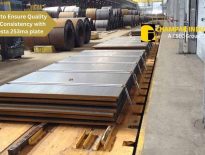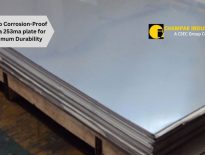SA 387 Grade 11 is a steel plate material with high-temperature properties, making it ideal for heat-resistant applications. This material is commonly used in fabricating boilers, pressure vessels, and heat exchangers in various industries such as oil and gas, chemical processing, and power generation. Cutting and fabricating this material requires special tools and techniques to guarantee dimensional accuracy and maintain the material’s integrity. In this blog post, we will discuss how to cut and fabricate SA 387 Grade 11 sheets for custom applications.
What are fabricated for 387 grade 11 sheets?
Fabricate SA 387 grade 11 sheets are special alloy steel sheets designed for high-temperature service. They are manufactured using a combination of chromium, molybdenum and manganese, which offer excellent corrosion resistance and elevated temperatures, making them suitable for pressure vessels and boilers operating at high pressures. The added benefit of these alloy steel sheets is their ability to retain strength up to 1500°F (816°C). They also possess superior impact toughness compared to other grades of low-alloy steels. This makes the alloy ASTM A387 grade 11 sheet an ideal choice in applications such as petrochemical process piping, heat exchangers, marine applications and off-shore oil rigs where exposure to extreme temperature conditions is expected.
How to Cut and fabricate SA 387 grade 11 sheets
- The first step in cutting and fabricating SA 387 Grade 11 sheets is to obtain the required size and thickness of the material. A plasma or water jet cutter can cut the sheet to the required dimensions. When using a plasma cutter, it is recommended to use an air plasma cutter with a high-temperature shielded nozzle to reduce dross formation, which can cause dimensional errors. On the other hand, a water jet cutter uses a high-pressure stream of water to cut the material, which produces precise cuts without affecting the material’s properties.
- After cutting the material to the required size and shape, the next step is to fabricate it into the desired form. Depending on the custom application, fabrication can be done using a combination of cutting, bending, welding, and machining techniques. When bending SA 387 Grade 11, it is important to use a v-die with a 90-degree angle to prevent wrinkles from forming on the material’s surface. Additionally, frequent annealing can be done to prevent cracking and maintain the material properties.
- Welding is another critical process in fabricating SA 387 Grade 11 sheets. Low hydrogen welding electrodes must be used to prevent hydrogen-induced cracking, which can occur when exposed to high temperatures. Alternatively, gas tungsten arc welding (GTAW) or gas metal arc welding (GMAW) can weld the material without affecting its properties. However, it is recommended to use preheat and post-weld heat treatments to reduce stress and improve the material’s toughness.
- Machining is the final step in fabricating SA 387 Grade 11 sheets. This process involves cutting or drilling the material to fit the custom application precisely. However, using a sharp tool to minimize heat production is essential, as this can cause microstructural changes in the material, affecting its mechanical properties. Additionally, a coolant during machining can reduce heat build-up and extend tool life.
Conclusion
In conclusion, cutting and fabricating SA 387 Grade 11 sheets for custom applications requires specialized tools and techniques to maintain the integrity of the material properties. Plasma or water jet cutting can cut the material to the required size and shape. Fabrication can be achieved through bending, welding, and machining techniques, which require attention to detail and careful consideration of the material’s properties. As a result, proper planning and execution are critical to achieving dimensional accuracy while maintaining the material’s high-temperature properties.







